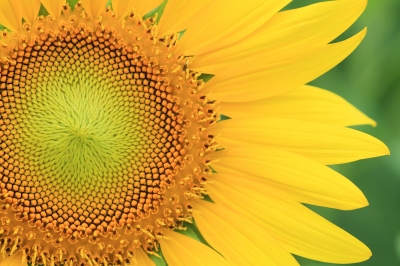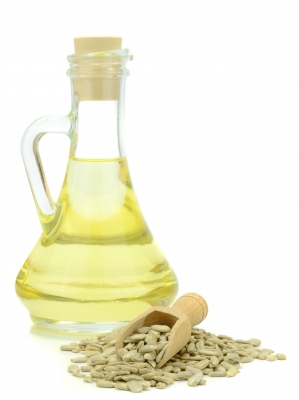Sunflower aka HELIANTHUS ANNUUS L. from Asteraceae family, is probably one of the most known flowers. It’s an annual plant, meaning it has to be planted every spring, because it cannot survive over winter. It grows high, up to 3 meters, and the flower head can measure 30 cm wide. It’s yellow, like the sun it likes to look at! Their resemblance to the sun brought them the name.
They grow best in fertile, wet, well-drained soil with a lot of mulch. Sunflowers need full sun, and they rotate after it all day long. They bloom in the beginning of July and lasts for 20 days. Nectar is mostly secreted during warm days and with morning dews at a temperature of 24-30 C. On a single plant there can be up to 1.500 flowers, of which the first ones produce the most nectar.
The flower head is an inflorescence made of hundreds or thousands of tiny  flowers called florets. The central florets look like the center of a normal flower, and the outer florets look like yellow petals. Because it’s big and yellow it is very easy to be seen by insects and birds which come to pollinate it.
flowers called florets. The central florets look like the center of a normal flower, and the outer florets look like yellow petals. Because it’s big and yellow it is very easy to be seen by insects and birds which come to pollinate it.
The sunflower is the state flower of Kansas. That is why Kansas is sometimes called the Sunflower State. There are other species from the same family, the most common one is California Royal Sunflower, which has a burgundy (red + purple) flower head.
 Sunflower Seeds and Oil
Sunflower Seeds and Oil
The flower produces thousands of seeds. We eat them raw or fried with salt. Industrially compressing the seeds gives us sunflower oil. It is commonly used in food as a frying oil, and in cosmetics as an emollient.
Sunflower oil was first industrially produced in 1835 in the Russian Empire. The world’s largest sunflower oil producers now are Ukraine, Russia and Argentina, but sunflower is largely cultivated for its oily seeds in many European countries, especially in Eastern and Southern ones. The production of unifloral sunflower honey depends a lot on the the extension of cultivation year by year, and is decided by the European agricultural policy.
Sunflower honey
Because there are large cultures of sunflowers, bees can find enough nectar and pollen.
In some countries sunflower honey is not that important as monofloral (unifloral) honey and it is often blended with other types.
Crystallization: It has a quick (2 months) and quite hard crystallization, because of its high glucose content. When crystallized it forms very small crystals with a refreshing taste (like “fondant”).
The pollen content registers a big variability from less than 20% to more than 90%, with a pollen-grain/10 g value mostly below 30 000.
Particularities: It has a unique bright yellow colour, a slightly high proline and acidity values, high glucose content, leading to a high content of fructose + glucose and a low fructose/glucose ratio. Most of the time, sunflower honey has a high water content, which leads to an elevated glucose / water ratio.
Low values were also recorded for sucrose and other oligosaccharides (according to Persano Oddo et al., 2000).
Sensory description:
Color: bright yellow of a medium intensity.
Smell/Aroma: floral – fresh fruit (fruity), warm and vegetal, not that intense.
Sweetness: medium
Acidity: strong
Bitterness: absent
Persistence/aftertaste: short
Composition of sunflower honey
According to “Main European unifloral honeys: descriptive sheets” by Livia PERSANO ODDO, Roberto PIRO and all, 2004, and published by Apidologie.org, 35 (2004) S38–S81© INRA/DIB-AGIB/ EDP Sciences, 2004, here are the values of the main components of honey:
Sunflower honey health benefits:
Lots of people think sunflower honey has no health benefits and it is not that nutritional. The truth is not like that. It has all the qualities every honey made of bees has, and in addition carries the particularities of the plant.
Apitherapy recommends it for stomach-intestine conditions, lung and kidney diseases, and especially for diseases of the heart and blood vessels. It is recommended for all heart patients, old folks say that with a homemade red wine, this honey offers faster results to those who have poor circulation in hands and feet.
Very useful for older people that need rest and additional energy (also used by its mental tonic properties), and children during their development (stimulates the immune system).
100% Natural, Raw Sunflower Honey 400g/14.11oz
Just like all the other honeys, it has anti-microbial properties. It is recommended for wound healing, dermatitis, rhinitis and sinusitis (used for lavage, diluted with water).
Again, just like all the other honeys, due to its content of antioxidants, sunflower honey is recommended for all types of cold or flu and their bad symptoms like sneezing, sore throat and fever.
Simply dissolve a teaspoon of honey in your warm (not hot) tea and enjoy it. Remember that you need like 5,6 tablespoons of honey per day (for an adult) in acute conditions.
Recipes for colds and flu:
• 100 grams of honey is mixed with the juice of one and half a lemon, take 2 tbsp. spoon 3 times a day.
• As expectorant: use plenty of sunflower honey in a plantain tea.
• For cough, sore throat and fever use sunflower honey when making the black radish syrup. Adults and children should take 1 tbsp. 3 times a day, 20-30 minutes before eating. In acute episodes you can take even more.
To strengthen and improve hair growth: There are people saying this recipe works, I’ve never tried it: At 4 parts of onion pulp add 1 part of sunflower honey, rub this mixture on the hair roots and after 30 minutes rinse with warm water. Add some olive oil if your hair is dry.
For spastic constipation: Mix 1 part honey with two parts of the pulp of pumpkin or pumpkin porridge. Eat 3-4 tablespoons 4-5 times a day. Or, for even better results use honeydew honey.
And here is a weird recipe I have found on keepingbee.org, as recommended for lung disease: 200 ml. of carrot juice, beetroot and horseradish, mix with 30 ml. of vodka, add 200 ml. of sunflower honey, add the juice of 2 lemons and mix everything in enamelware for 30 minutes at a temperature of 25-30 ° C (86 °F). Take 1 tbsp. for 20-30 minutes before each meal.
It might be an old Indian remedy, I’m not sure, if you know more about it, please leave a comment below.
Sunflower seeds benefits:
If you love to eat sunflowers seeds, then you have already benefited of its amazing health properties.
The seeds contain: selenium (prevents cancer), magnesium and copper (needed for the health of bones, nerves, stress, migraines and helping you relax), Vitamin E (for skin, arthritic pain), antioxidants etc.
Other types of honey:
Basswood – linden – lime honey
Mint Honey
Manuka honey
Lifemel honey
Ikaria honey
Sidr honey
Tualang honey
Mad honey
![]()
References and picture sources:
simple.wikipedia.org;
en.wikipedia.org;
Apidologie.org;
“Two sunflowers” picture by Brooke via flickr.com;
“Close-up Of Sunflowers” picture credit foto76 via freedigitalphotos.net;
“A Bottle Of Sunflower Cooking Oil And Seeds” by Mister GC via freedigitalphotos.net





